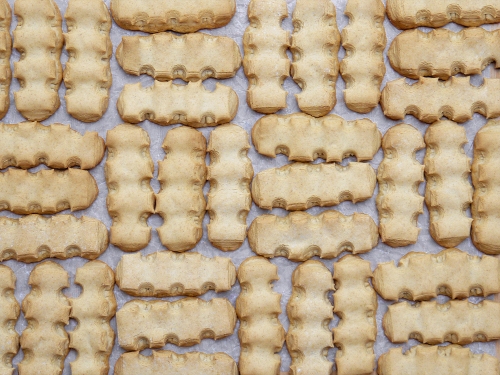Last year I had great success with walnut cookies from Slovakia that looked like walnuts. So I was naturally delighted to find another Slovakian recipe, this time for ginger cookies. And guess what? They’re shaped to look like root ginger. Pretty clever, yes?

I loved the look of these cookies as they combine three things I really like in baking – an interesting shape, lots of warming ginger, and I get to use baker’s ammonia (aka my favourite novelty raising agent). Fun times!
Baker’s ammonia is an uncommon ingredient today, but is has a long history that pre-dates baking powder (indeed, baking powder was invented only as recently as 1843 by Alfred Bird when he was looking for a leavener that was both egg and yeast-free). Baker’s ammonia was originally derived from the ground-up antlers of red deer, hence its other name “salt of hartshorn”, but it is now made chemically.
In its pure state, it has a really pungent smell of ammonia and you can’t eat it, but the benefit of baker’s ammonia is that it gives cookies great lift and crispness as it breaks down completely during baking to create gas. This does mean when you open the oven door you are treated to a really pungent waft of ammonia. The cookies themselves are completely ammonia-free, but it is important that anything you make with baker’s ammonia is fairly thin so that they can expand and that stinky gas can escape. For this reason it is not used as a raising agent in cakes. And be warned – you can’t try the cookie dough that has baker’s ammonia in it!
You can see in the picture below what effect baker’s ammonia has. The cookies will double or triple in height during baking creating a lightness that baking powder can’t beat.

You might look at this recipe and wonder if two tablespoons of ginger is really right? Yes it is. The flavour is ginger, and only ginger (with the addition of a dash of vanilla, which the Flavour Thesaurus tells me is a good pairing). So if you’re making a cookie which is all about ginger, then you really want to make sure that there is enough in there to really pack a punch. After baking the flavour really is delicious – they’re fairly sweet, but after a moment the warmth of the ginger tempers that. Heck, you might even want to add a third tablespoon of ginger is you want them really fiery. And if you wanted to make them even more special, dipping the bases into dark chocolate would be fabulous, as you’ll have the awesome ginger-chocolate combination along with the crunchy biscuit.
There is also a special cutter for making zázvorníky. I’ve seen people describe it as looking like a piece of ginger root, and that is enough for me. If walnut cookies are shaped like walnuts, it is just a matter of logic that ginger cookies should look like ginger. But it does feel like we are starting to veer into Doctor Seuss territory where cookies must only ever be shaped like the thing they are flavoured with.

Sadly, I could not find a zázvorníky cutter anywhere, so I had to improvise. I had three options. First, I could have gone online and ordered a bespoke cookie cutter based on my design which would be 3D printed. This was my original plan, but I’ve been warned on more than one occasion that I have too much kitchen equipment already. Second, you could just freestyle them with a knife and perhaps a paper template, which I think could be very meditative but would also take a bucket load of patience.
Which brings me to the third option: I improvised by cutting the rolled dough into rectangles (2x8cm), then I used a large round piping nozzle to cut half-circles along the sides. This proved to be really easy and effective, plus I got a bit of credit for not buying another single-use item. Win-win!
These cookies need to rest overnight, and in the morning you get to bake them with the joy of your kitchen already being clean. The drying is essential – it means they keep their shape, and the lift from the ammonia is directed down so that the gain a lot of height. As a result, I think they do sort of look like ginger rhizomes after baking. What do you think?
I really enjoyed these. They’re fairly easy to make, and the shape is unique and fun, and they really taste great. A clear yes from me.
To make Zázvorníky (makes 50)
• 250g plain flour, plus 50-75g extra as needed
• 2 tablespoons ground ginger
• 1/2 teaspoons baker’s ammonia
• pinch of salt
• 250g icing sugar
• 2 large eggs, at room temperature
• 4 tablespoons melted butter, cooled
• 1/4 teaspoon vanilla extract
1. Put 250g flour, ginger, baking ammonia and salt into a bowl. Mix well and set aside.
2. In a separate bowl, add the eggs and icing sugar. Beat with an electric whisk until pale and fluffy, around 5 minutes. The mixture is done when a lifted beater leaves a “ribbon” on the mixture.
3. Add the cooled melted butter (and vanilla if using) and fold gently. Finally, add the flour mixture and mix well until if forms a firm dough. You may need to add more plain flour – add 25g at a time until you have a firm dough. I added an extra 50g in total.
4. Roll out the dough to about 1/2 cm thickness. Cut out whatever shapes take your fancy, and transfer to a baking sheet. You can make different shapes, but try to keep the same sizes on each sheet so that they bake evenly. I cut rectangles of 2×8 cm, then used a large piping nozzle to cut semi-circles along the edges.
5. Leave the cookies to rest, uncovered, overnight so that the tops dry out.
6. The next day, preheat the oven to 170°C (340°F). Bake the cookies for 10-12 minutes. They are done when they are puffed up and lightly golden. Remove from the oven and allow to cool.
Note – store in an airtight container. Cookies made with baker’s ammonia can soften over time, but you can restore their crunch by putting them in a low oven for a few minutes to dry them out a little.



































